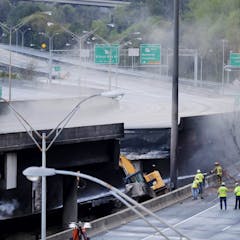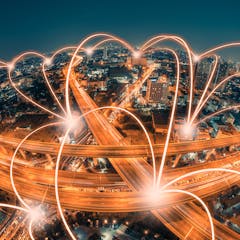
Articles on Freight
Displaying 1 - 20 of 25 articles

Trains once carried most of our freight. Could a return to rail help us meet our emissions cutting goals?

Transportation agencies plan for events like major bridge or highway collapses, but these events can disrupt traffic for months and affect residential neighborhoods as well as motorists.

President Joe Biden called on Congress to intervene to avoid a strike that he said would ‘devastate our economy.’

As California goes on regulating air pollution, other states often follow – including the Golden State’s ambitious goals for cleaning up emissions from trucking.

The rise of e-commerce means billions of packages are delivered in the US each year. That creates traffic and pollution, but urban freight researchers are finding better way to get goods to customers.

Improving the rail link between Australia’s two biggest cities will have many benefits, not least in meeting our carbon-reduction goals

With authorities expecting further congestion at UK ports, a range of solutions will be needed to minimise queuing for travellers

As President Biden signs the bipartisan infrastructure bill, it’s important to determine which road, freight and information networks are the most vital to protect.

Heavy goods vehicles predominantly run on diesel. Here are three options for eliminating their emissions.

Direct implications for maritime security are unlikely. But there will be ripple effects in the shipping industry and in many commercial sectors.

Irish trade with the EU contributes an additional 34 tonnes of toxic nitrogen oxides to air in the UK each year.

Carbon emissions from maritime freight are everyone’s problem because of climate change.

Rising e-commerce means more delivery trucks and urban gridlock. Lockers at transit centers, where carriers can leave packages for people who live or work nearby, are a potential solution.

Supply-chain experts see reliable data, STEM education and smarter regulation as essential for Australia to succeed in an increasingly automated world under pressure to be environmentally sustainable.

Sweden’s smart road allows electric cars to charge in motion. But alternative technologies might be a better option.

New research finds small drones on short deliveries use less carbon than the equivalent vehicles.

As the Lac Mégantic rail disaster trial begins, here’s how technology can help prevent a repeat of the tragedy that killed 47 people.

Online shopping giants and logistics firms are trying to improve efficiency and cut carbon – knowing that doing so will reduce their operating costs while appealing to green-minded consumers.

When planning major infrastructure investments, it’s important to know which road, freight and information networks are most important – and which proposals might make things worse, not better.

Cargo that automatically reports to customs, containers that monitor their contents, and robots that pick and pack at either end: technology is changing freight, forever.
